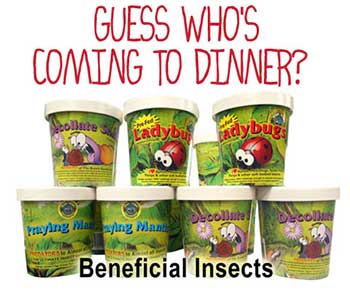Beneficial Insects

They’re Not All Bad!
Your garden is now ripe for a devastating invasion of aphids, slugs and snails. Before we devise our battle plan to rid your garden of these pests, let’s look at the inter-relationships in your backyard!
Who’s an organic gardener going to turn to for help? Beneficial Insects of course! These beneficial insects are the natural enemies of garden pests. That’s great news for growers because it means there is an effective, non-toxic approach for solving your bug blues.
Aphids are to ants what cows are to humans. Ants actually protect and herd aphids for the honeydew nectar they secrete. Ants use their antennae to stroke the aphids, thereby activating the secretion cycle.
Thus, ant control should be part of the preventative cycle regarding aphid infestation. Get rid of the ants and it is much easier to get rid of their herds! We recommend AntPro Bait with the AntPro Bait Station, which meets standards for organic use and won’t harm beneficial insects! The ants will take the bait back to their colonies, which will kill them all.
Aphids can be brought under control culturally if the infestation is moderate. Often a thorough hosing of the afflicted plants will wash aphids away.
Biological controls include ladybugs and
praying mantis colonies. Organic solutions include insecticidal soaps or pyrethrums.
Snails are also active with our combination of heat and moisture. In most cases, snails are easily controlled with bait products. For the more exotic approach, there is a biological control for the common brown snail by utilizing a distant cousin, the Ladybugs
Nearly everyone can recognize ladybugs, but perhaps not so many could identify their larvae. While the adults are almost universally regarded as harmless, their small, armadillo-like, blue and orange larvae are likely to be treated with more suspicion, and are often destroyed “to be on the safe side.”
Both adults and, more particularly, larvae feed on large numbers of insect pests, especially aphids. A single larva can consume up to 500 aphids in its three-week life. Before emerging as an adult ladybug, the larva pupates, and the yellow pupa may be mistaken for a Colorado beetle, which it superficially resembles. Ladybugs are most commonly red with either two or seven black spots, but they may also be black with red spots, yellow with black spots and black with yellow spots.
Praying Mantis
A single juvenile mantis can eat hundreds of mosquitos, moths and aphids. As they mantis gets older and bigger it will eat beetles, moths and even grasshoppers. They are very effective at policing your garden. Place egg sacks in your garden in spring or fall. During warmer weather you can purchase the eggs hatched or hatch them in an aquarium or other sheltered environment.
Decollate Snail
These pests are not the same as your helix snail, which are the common nuisance found eating your savory vegetable plants. The decollate snail is a natural hunter of helix snails and their eggs. They will clean your garden for you.
Wasps
Wasps, as everyone knows, sting, and at the end of the summer they are a real nuisance, feasting on ripe fruit, and ruining picnics and outdoor meals. Leaving aside this antisocial behavior, for the rest of the year they are a definite asset to gardeners because they collect all manner of soft-bodied grubs and insects to feed to the young wasp larvae in the nest. Other, less highly visible wasps are also extremely useful – several species are parasitic, laying eggs in the bodies of insect pests that hatch out and slowly consume their hosts. Ichneumon wasps are some of the best known, though rarely recognized in the garden. They have long, slender bodies and are not brightly colored like the common wasp.











